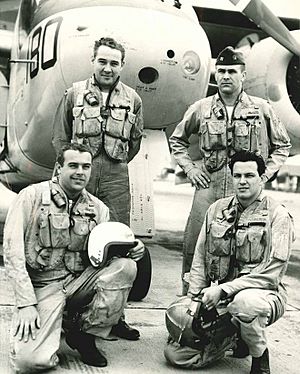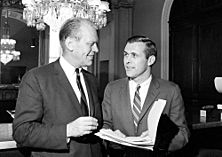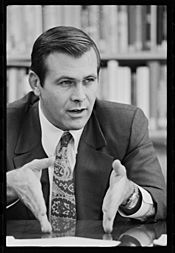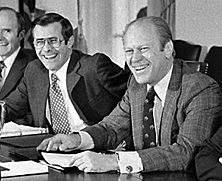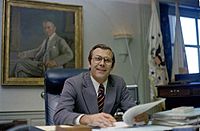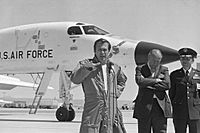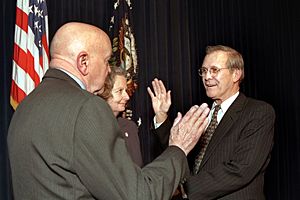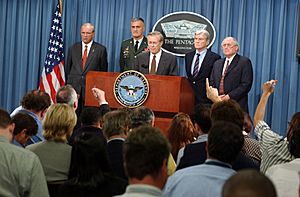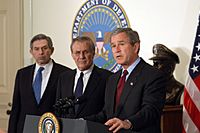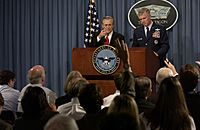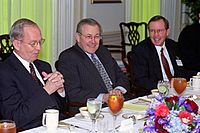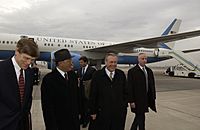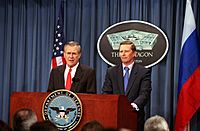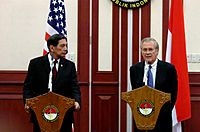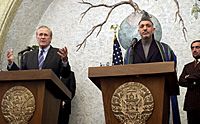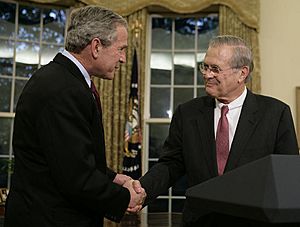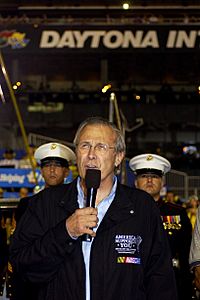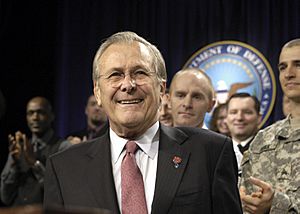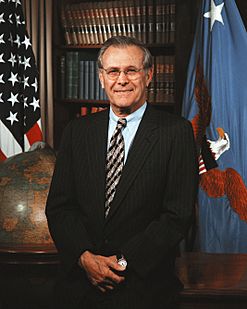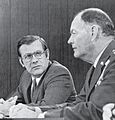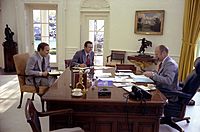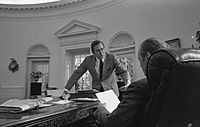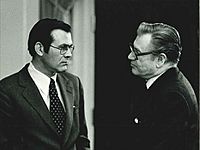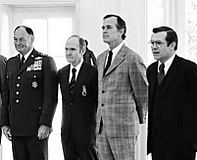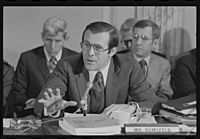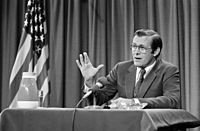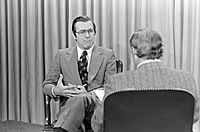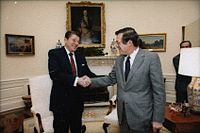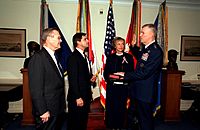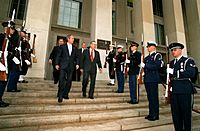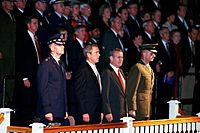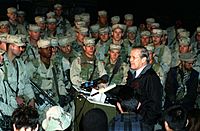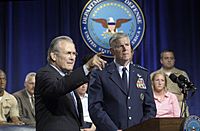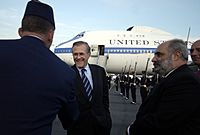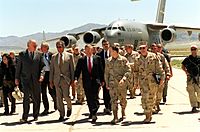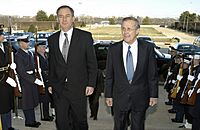Donald Rumsfeld facts for kids
Quick facts for kids
Donald Rumsfeld
|
|
|---|---|
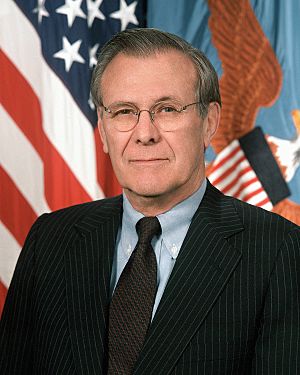
Official portrait, 2001
|
|
| 13th and 21st United States Secretary of Defense | |
| In office January 20, 2001 – December 18, 2006 |
|
| President | George W. Bush |
| Deputy | |
| Preceded by | William Cohen |
| Succeeded by | Robert Gates |
| In office November 20, 1975 – January 20, 1977 |
|
| President | Gerald Ford |
| Deputy | Bill Clements |
| Preceded by | James Schlesinger |
| Succeeded by | Harold Brown |
| 6th White House Chief of Staff | |
| In office September 21, 1974 – November 20, 1975 |
|
| President | Gerald Ford |
| Preceded by | Alexander Haig |
| Succeeded by | Dick Cheney |
| 9th United States Ambassador to NATO | |
| In office February 2, 1973 – September 21, 1974 |
|
| President |
|
| Preceded by | David Kennedy |
| Succeeded by | David Bruce |
| Director of the Cost of Living Council | |
| In office October 15, 1971 – February 2, 1973 |
|
| President | Richard Nixon |
| Preceded by | Position established |
| Succeeded by | Position abolished |
| Counselor to the President | |
| In office December 11, 1970 – October 15, 1971 Serving with Robert Finch
|
|
| President | Richard Nixon |
| Preceded by |
|
| Succeeded by | Robert Finch |
| 3rd Director of the Office of Economic Opportunity | |
| In office May 27, 1969 – December 11, 1970 |
|
| President | Richard Nixon |
| Preceded by | Bertrand Harding |
| Succeeded by | Frank Carlucci |
| Member of the U.S. House of Representatives from Illinois's 13th district |
|
| In office January 3, 1963 – May 25, 1969 |
|
| Preceded by | Marguerite Church |
| Succeeded by | Phil Crane |
| Personal details | |
| Born |
Donald Henry Rumsfeld
July 9, 1932 Chicago, Illinois, U.S. |
| Died | June 29, 2021 (aged 88) Taos, New Mexico, U.S. |
| Resting place | Arlington National Cemetery |
| Political party | Republican |
| Spouse |
Joyce Pierson
(m. 1954) |
| Children | 3 |
| Education | Princeton University (AB) Case Western Reserve University Georgetown University |
| Signature | |
| Nickname | "Rummy" |
| Military service | |
| Branch | United States Navy |
| Years of service |
|
| Rank | Captain |
Donald Henry Rumsfeld (July 9, 1932 – June 29, 2021) was an American politician and businessman. He served as Secretary of Defense twice. First, from 1975 to 1977 under President Gerald Ford. Then again from 2001 to 2006 under President George W. Bush. He was both the youngest and the oldest person to hold this position.
Rumsfeld also served as a U.S. Congressman for Illinois from 1963 to 1969. He was the director of the Office of Economic Opportunity (1969–1970). He also worked as a counselor to the president (1969–1973). Later, he became the U.S. Representative to NATO (1973–1974). He was also the White House Chief of Staff (1974–1975). Between his times as Secretary of Defense, he led several companies.
Born in Illinois, Rumsfeld went to Princeton University. He graduated in 1954 with a degree in political science. After serving in the Navy for three years, he ran for Congress. He won in 1962 when he was 30 years old. President Richard Nixon later appointed him to lead the Office of Economic Opportunity in 1969. He also led the Economic Stabilization Program. Then he became the ambassador to NATO.
In 1974, President Ford called Rumsfeld back to Washington. Ford appointed him as his chief of staff. In 1975, Ford nominated Rumsfeld to be Secretary of Defense. After Ford lost the 1976 election, Rumsfeld went back to business. He became the CEO and chairman of several companies, including G. D. Searle & Company and Gilead Sciences.
President George W. Bush appointed Rumsfeld as Secretary of Defense again in January 2001. In this role, Rumsfeld was key in planning the invasion of Afghanistan and the invasion of Iraq. He resigned in late 2006. In his retirement, he wrote an autobiography, Known and Unknown: A Memoir. He also wrote Rumsfeld's Rules: Leadership Lessons in Business, Politics, War, and Life.
Contents
Early Life and Education
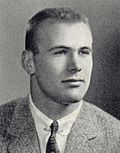
Donald Henry Rumsfeld was born on July 9, 1932, in Chicago, Illinois. His parents were Jeannette Kearsley and George Donald Rumsfeld. His father's family came from Germany in the 1870s. Donald grew up in Winnetka, Illinois. He became an Eagle Scout in 1949. He later received the Distinguished Eagle Scout Award and the Silver Buffalo Award. From 1943 to 1945, his family lived in Coronado, California. This was while his father served in the Navy during World War II.
Rumsfeld went to Baker Demonstration School and New Trier High School. He then attended Princeton University with scholarships. He graduated in 1954 with a degree in politics. At Princeton, he was a skilled wrestler and captain of the wrestling team. He was also captain of the Lightweight Football team. While there, he became friends with Frank Carlucci, who also became Secretary of Defense.
Rumsfeld married Joyce P. Pierson on December 27, 1954. They had three children, six grandchildren, and one great-grandchild. He studied law at Case Western Reserve University School of Law and Georgetown University Law Center. However, he did not earn a degree from either.
Rumsfeld served in the United States Navy from 1954 to 1957. He was a naval aviator and a flight instructor. In 1957, he joined the Naval Reserve. He continued his service in flying and administrative roles. He retired with the rank of captain in 1989.
Career in Government (1962–1975)
Member of Congress
In 1957, Rumsfeld worked as an assistant to Congressman David S. Dennison Jr.. In 1959, he became a staff assistant to Congressman Robert P. Griffin. From 1960 to 1962, he worked at an investment banking firm. Then he decided to run for Congress.
He was elected to the United States House of Representatives for Illinois's 13th congressional district in 1962. He was 30 years old. He was re-elected three more times. In Congress, he served on committees dealing with economics, science, and government. He also helped create the Japanese-American Inter-Parliamentary Council. He was a key supporter of the Freedom of Information Act.
In 1965, Rumsfeld suggested that Gerald Ford should lead the Republicans in the House. Ford won and became House Minority Leader. Rumsfeld and others who supported Ford were known as the "Young Turks". Rumsfeld later worked for Ford as his chief of staff in 1974. Ford then chose him to be Secretary of Defense in 1975.
During his time in Congress, Rumsfeld worried about the U.S. effort in the Vietnam War. He felt President Johnson was too confident. He visited Vietnam to see the situation for himself. This trip made him believe that South Vietnam depended too much on the U.S. He tried to get the House to debate the war's management, but it was blocked.
Rumsfeld also attended seminars at the University of Chicago. There, he learned about the idea of an all-volunteer military. He also met economist Milton Friedman. He voted for the Civil Rights Acts of 1964 and 1968, and the Voting Rights Act of 1965.
Nixon Administration
Rumsfeld left Congress in 1969 to work for President Nixon. Nixon made him director of the United States Office of Economic Opportunity (OEO). This job had a high rank, like a Cabinet member. Rumsfeld had voted against creating the OEO when he was in Congress. He initially didn't want the job. But he accepted after Nixon promised him a role as an assistant to the President. As director, Rumsfeld wanted to make the OEO a place for new programs. He saved helpful anti-poverty programs by moving money from less successful ones. During this time, he hired Frank Carlucci and Dick Cheney.
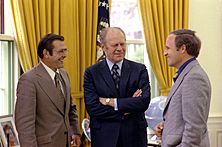
In December 1970, Nixon made Rumsfeld Counselor to the President. He kept his Cabinet status. He also became director of the Economic Stabilization Program in 1970. He later led the Cost of Living Council.
In February 1973, Rumsfeld became the U.S. Ambassador to NATO in Brussels, Belgium. He represented the U.S. in military and diplomatic matters. He also helped mediate a conflict between Cyprus and Turkey.
Ford Administration
In August 1974, after Nixon resigned, Rumsfeld returned to Washington. He helped with the transition for the new president, Gerald Ford. Rumsfeld had been Ford's friend since their time in the House. Ford appointed Rumsfeld as White House Chief of Staff. He served in this role from 1974 to 1975.
Secretary of Defense (1975–1977)
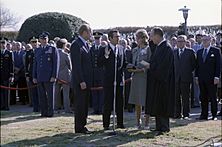
In October 1975, Ford changed his Cabinet. Ford named Rumsfeld as the 13th U.S. Secretary of Defense. He also appointed George H. W. Bush to lead the CIA. Rumsfeld's confirmation hearing began on November 12, 1975. He was asked about the Cold War. He said the Soviet Union was a "clear and present danger." On November 17, 1975, Rumsfeld was confirmed by a vote of 97–2. At 43, he became the youngest Secretary of Defense at that time.
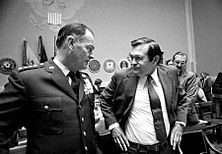
As Secretary of Defense, Rumsfeld oversaw the change to an all-volunteer military. He worked to increase the defense budget. He wanted to build up U.S. military forces. He believed that U.S. military strength had been declining compared to the Soviet Union. He oversaw the creation of cruise missiles, the B-1 bomber, and a large naval shipbuilding program.
Rumsfeld also stressed the importance of the space program. He organized cooperation between the Department of Defense and NASA. This led to the development of Skylab and the Space Shuttle program.
Rumsfeld also urged President Ford to support the Indonesian government. This was to help them fight against communist groups in East Timor. This led to the Indonesian invasion of East Timor in December 1975.
SALT II Treaty
Rumsfeld worked to complete the SALT II Treaty. He drafted the treaty with General George Scratchley Brown. However, it was not signed until the Carter administration.
In 1977, Rumsfeld received the Presidential Medal of Freedom. This is the nation's highest civilian award. His first term as Secretary of Defense ended on January 20, 1977. Harold Brown succeeded him.
-
Secretary of Defense Donald Rumsfeld at his office in The Pentagon.
-
U.S. Secretary of Defense Donald Rumsfeld with Journalist and Television host Martin Agronsky at Rumsfeld's Office in The Pentagon.
-
Secretary of Defense Donald Rumsfeld with President-Elect Jimmy Carter and Chairman of the Joint Chiefs of Staff General George S. Brown and the other members of the Joint Chiefs of Staff during a tour at The Pentagon on December 17, 1976.
-
U.S. Secretary of Defense Donald Rumsfeld following a test flight on a brand new Strategic Bomber aircraft Rockwell B-1 Lancer, April 1976.
Return to Private Sector (1977–2000)
Business Career
In early 1977, Rumsfeld lectured at Princeton and Northwestern. He then turned to business. From 1977 to 1985, he was CEO, president, and chairman of G. D. Searle & Company. This was a global pharmaceutical company. He helped the company improve its finances. He was recognized as an outstanding CEO in the pharmaceutical industry. In 1985, Searle was sold to the Monsanto Company.
Rumsfeld was chairman and CEO of General Instrument from 1990 to 1993. This company worked on broadband technology. It helped develop the first all-digital high-definition television (HDTV) technology. After making the company profitable, Rumsfeld returned to private business.
From 1997 to 2001, Rumsfeld was chairman of Gilead Sciences, Inc.. Gilead developed Tamiflu, a medicine for the flu. His shares in the company grew when bird flu became a concern. Rumsfeld avoided making decisions that involved Gilead while he was Secretary of Defense.
Part-time Public Service
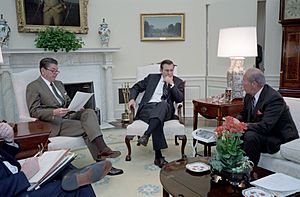
During his business career, Rumsfeld also served in public roles. In November 1983, President Ronald Reagan appointed him as a special envoy to the Middle East. This was during the Iran–Iraq War. The U.S. wanted Iraq to win. Rumsfeld was sent to help mediate.
He visited Baghdad on December 20, 1983, and met Saddam Hussein. They discussed opposing Syria's actions and preventing arms sales to Iran. Rumsfeld also mentioned U.S. concerns about Iraq's use of chemical weapons.
Rumsfeld also served on various committees and commissions. He was chairman of the Commission to Assess the Ballistic Missile Threat to the United States in 1998. This commission concluded that some countries could develop long-range missiles quickly.
He was a member of the Project for the New American Century, a group that supported U.S. leadership. He also advised the U.S. State Department on foreign policy.
Presidential Aspirations
Rumsfeld received votes for Vice President in the 1976 Republican National Convention and 1980 Republican National Convention, though he was not seeking the office.
He briefly sought the presidential nomination in 1988. He withdrew before the primary elections. In the 1996 election, he considered running but decided not to. Instead, he became national chairman for Bob Dole's campaign.
Secretary of Defense (2001–2006)
Rumsfeld became Secretary of Defense again in January 2001 under President George W. Bush. His second term was very important. After the September 11 attacks, Rumsfeld led the military planning for the U.S. invasion of Afghanistan and the invasion of Iraq. He wanted to send a smaller force quickly to both conflicts. This idea was called the Rumsfeld Doctrine.
Rumsfeld was known for being direct and witty in press conferences. However, his leadership faced criticism, especially regarding the Iraq conflict.
September 11, 2001 Attacks
On September 11, 2001, terrorists hijacked planes. They crashed them into the World Trade Center and the Pentagon. A fourth plane crashed in Shanksville, Pennsylvania. Within hours, Rumsfeld raised the U.S. defense alert level to DEFCON 3. This was the highest it had been since 1973.
Rumsfeld spoke to the nation from the Pentagon just eight hours after the attacks. He said, "The Pentagon's functioning. It will be in business tomorrow."
Military Decisions After 9/11
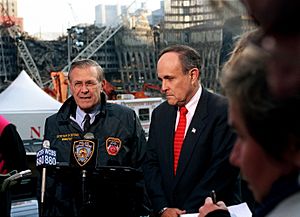
On September 11, Rumsfeld quickly ordered his aides to look for signs of Iraqi involvement. In the first emergency meeting, Rumsfeld asked, "Why shouldn't we go against Iraq, not just al-Qaeda?" This idea was initially rejected. But Rumsfeld and his deputy, Paul Wolfowitz, continued to push for it. They created a policy called the Bush Doctrine, which focused on "pre-emption" and a war on Iraq.
Richard A. Clarke, a White House counter-terrorism coordinator, said Rumsfeld wanted to bomb Iraq. Clarke said, "there aren't any good targets in Afghanistan and there are lots of good targets in Iraq." Rumsfeld later wrote that it would have been irresponsible not to ask about Iraq's involvement.
A memo from Rumsfeld in November 2001 considered a war with Iraq. It listed possible reasons for a U.S.-Iraq War.
War in Afghanistan
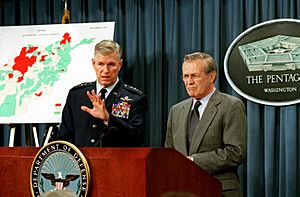
Rumsfeld led the planning for the War in Afghanistan. General Tommy Franks first suggested invading with 60,000 troops. Rumsfeld feared a long conflict, like what happened to the Soviets. He said, "I want men on the ground now!" Franks then proposed using U.S. Special Forces.
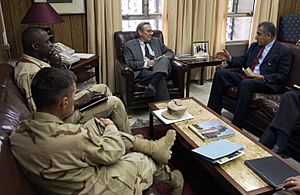
On October 7, 2001, Rumsfeld announced the invasion of Afghanistan. He stated, "Our objective is to defeat those who use terrorism and those who house or support them." He said the U.S. would not stop until terrorist networks were "rooted out." In November 2001, Rumsfeld announced that a key al-Qaeda leader, Mohammed Atef, was killed.
In March 2002, Rumsfeld updated on Operation Anaconda. He said forces were searching caves and clearing battle areas. He visited U.S. troops in Afghanistan in December 2001 and May 2003. In 2003, he stated that major combat was over, moving to "stability and reconstruction."
A 2009 Senate report criticized Rumsfeld and General Franks. They believed not enough troops were sent to the Battle of Tora Bora in 2001. They thought Osama bin Laden might have been there and escaped. This escape may have made the war in Afghanistan longer.
Iraq War
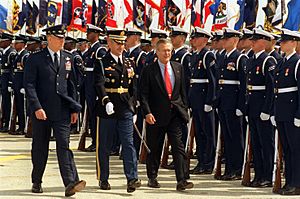
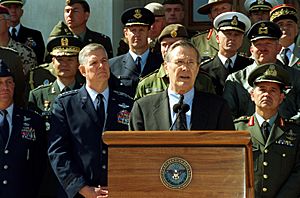
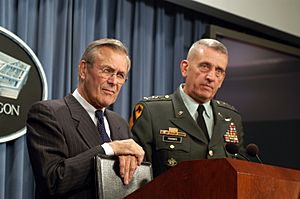
Before the Iraq War, Rumsfeld claimed Iraq had a weapons of mass destruction program. He famously said, "there are known knowns" about this. However, no stockpiles were ever found. Some officials also claimed a link between Al Qaeda and Saddam Hussein. A Pentagon report found that Rumsfeld's aide created different intelligence assessments.
Rumsfeld and Wolfowitz set up a special group called the "Office of Special Plans (OSP)." This group was meant to find evidence that Saddam Hussein had ties to Al Qaeda and weapons.
On January 22, 2003, Rumsfeld called Germany and France part of "Old Europe." This was after they opposed invading Iraq.
Rumsfeld thought the initial plan for 500,000 troops in Iraq was too many. He believed fewer troops would be needed. On February 27, 2003, he said the idea of "several hundred thousand U.S. forces I think is far from the mark."
On March 20, 2003, Rumsfeld announced the start of the Iraq invasion. He said, "The days of the Saddam Hussein regime are numbered." The invasion, called Shock and Awe, was quick. Baghdad fell in less than a month with few American casualties. However, many buildings and museums were looted. A violent insurrection began soon after.
On March 30, 2003, Rumsfeld said, "We know where they are." He was referring to weapons of mass destruction. On April 9, 2003, during the Fall of Baghdad, he described "scenes of free Iraqis celebrating."
After the invasion, U.S. troops were criticized for not protecting historical items. On April 11, 2003, Rumsfeld said, "Stuff happens... and it's untidy and freedom's untidy." He added, "The images you are seeing on television you are seeing over, and over, and over, and it's the same picture of some person walking out of some building with a vase, and you see it 20 times, and you think, 'My goodness, were there that many vases?'"
On July 24, 2003, Rumsfeld commented on releasing photos of Saddam Hussein's dead sons. He said it was important for Iraqis to know they were gone.
In October 2003, Rumsfeld approved a secret plan for public relations. He wanted to remind Americans of the 9/11 attacks. He also ordered responses to negative news reports about the war.
On December 14, 2003, Rumsfeld said Saddam Hussein "was cowering in a hole in the ground." He felt Hussein "seemed not terribly brave."
Rumsfeld regularly visited U.S. troops in Iraq. He said it was unrealistic to wait for Iraq to be peaceful before removing troops. On August 2, 2006, he spoke about sectarian violence. He said, "Sunnis are killing Shi'a and Shi'a are killing Sunnis."
On October 26, 2006, Rumsfeld said that defeat in Iraq would be bad. He stated, "Those who are fighting against the Iraqi government want to seize power." He said the military was adapting to problems.
-
President George W. Bush, Defense Secretary Rumsfeld, and Deputy Secretary Wolfowitz in March 2003
-
United States Secretary of Defense Donald Rumsfeld with former United States Air Force Chief of Staff General Larry D. Welch.
-
Rumsfeld with Indonesian Minister of Defense Juwono Sudarsono in Jakarta, Indonesia, June 7, 2006.
-
Rumsfeld with Afghanistan's President Hamid Karzai during a press conference in Kabul, Afghanistan on April 13, 2005.
-
Rumsfeld with Major General Karl Eikenberry during a visit to Afghan Army Military Training Center in Kabul, Afghanistan on May 1, 2003.
In December 2004, Rumsfeld was criticized for using a signing machine for condolence letters. He promised to sign all future letters personally.
Resignation
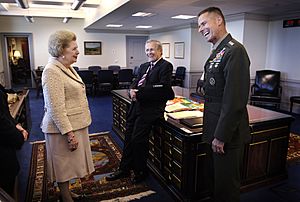
Some retired generals called for Rumsfeld to resign in 2006. They accused him of poor military planning. Rumsfeld said that if every time a few people disagreed, the Secretary of Defense changed, it would be "like a merry-go-round." President Bush defended Rumsfeld.
On November 1, 2006, Bush said he would keep Rumsfeld. However, Rumsfeld wrote a resignation letter on November 6, 2006. After the elections on November 8, Bush announced Rumsfeld's resignation. Bush nominated Robert Gates to replace him. A farewell ceremony was held for Rumsfeld on December 15, 2006.
Retirement and Later Life (2006–2021)
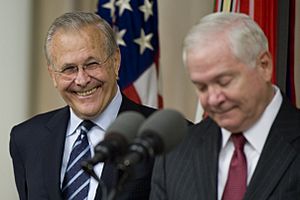
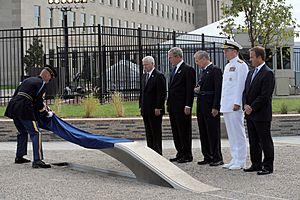
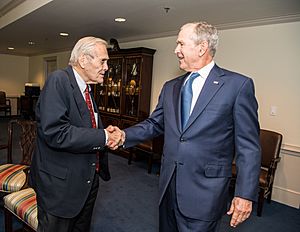
After resigning, Rumsfeld wrote a memoir called Known and Unknown: A Memoir. It was released on February 8, 2011. He did not take an advance payment for the book. He donated all proceeds to veterans groups. He also created "The Rumsfeld Papers" website. It has over 4,000 documents from his time in government.
In 2007, Rumsfeld started The Rumsfeld Foundation. It supports public service in the U.S. and free political and economic systems abroad. Rumsfeld personally funded the foundation.
In February 2011, Rumsfeld supported ending the "Don't ask, don't tell" policy. This policy prevented gay and lesbian people from serving openly in the military. He said it was "an idea whose time has come."
In October 2011, Rumsfeld was interviewed by Al Jazeera. He was asked if enough troops were sent to Iraq. He disagreed with the idea that Pentagon officials told him the number was too low.
Rumsfeld was the subject of a 2013 documentary called The Unknown Known. The title refers to his famous quote from a 2002 press conference. In the film, he talks about his career from the 1960s to planning the Iraq invasion.
In January 2016, Rumsfeld released a mobile app game called Churchill Solitaire. It was based on a card game played by Winston Churchill. Profits from the game were donated to charity.
In June 2016, Rumsfeld announced he would vote for Donald Trump in the 2016 presidential election.
On January 5, 2021, Rumsfeld and nine other former Secretaries of Defense sent a letter. They warned President Trump not to involve the military in the 2020 presidential election dispute.
Death
On June 29, 2021, Rumsfeld died from multiple myeloma at his home in Taos, New Mexico. He was buried in Arlington National Cemetery on August 24, 2021.
Electoral History
Rumsfeld ran for Congress four times. He received between 58% and 76% of the votes. In 1975 and 2001, the U.S. Senate strongly approved his appointments as Secretary of Defense.
Awards
Rumsfeld received 11 honorary degrees. He was recognized as an Outstanding CEO in the pharmaceutical industry.
Some of his other awards included:
- All Navy Wrestling Champion (1956)
- The Presidential Medal of Freedom (with Distinction) by President Ford (1977)
- Golden Plate Award of the American Academy of Achievement (1983)
- George C. Marshall Medal by the Association of the U.S. Army (1984)
- Woodrow Wilson Medal by Princeton University (1985)
- Dwight D. Eisenhower Medal (1993)
- Lone Sailor Award by the U.S. Navy Memorial Foundation (2002)
- Statesmanship Award by the United States Association of Former Members of Congress (2003)
- Ronald Reagan Freedom Award (2003)
- James H. Doolittle Award by the Hudson Institute (2003)
- Gerald R. Ford Medal presented by President Ford and the Ford Foundation (2004)
- Distinguished Eagle Scout Award by the Boy Scouts of America (1976)
- Grand Cross of the Order of Merit of the Republic of Poland (2005)
- Union League of Philadelphia Gold Medal for Citizenship (2006)
- Claremont Institute Statesmanship Award (2007)
- Victory of Freedom Award from the Richard Nixon Foundation (2010)
- Order of Anthony Wayne from Valley Forge Military Academy
- Special Grand Cordon of the Order of Brilliant Star (2011, Republic of China)
- National Flag award from Albania's President Bujar Nishani (2013)
- Grand Cordon of the Order of the Rising Sun (2015)
Government Posts and Commissions
- Secretary of Defense (2001–06)
- U.S. Commission to Assess National Security Space Management and Organization: chairman (2000)
- U.S. Trade Deficit Reviews Commission: member (1999–2000)
- Commission to Assess the Ballistic Missile Threat to the United States: chairman (1998)
- National Commission on Public Service: member (1987–1990)
- National Economic Commission: member (1988–1989)
- President Reagan's General Advisory Committee on Arms Control: member (1982–1986)
- U.S. Joint Advisory Commission on U.S./Japan Relations: member (1983–1984)
- Presidential Envoy to the Middle East, Reagan administration (1983–1984)
- Presidential Envoy on the Law of the Sea Treaty, Reagan administration (1982–1983)
- Secretary of Defense (1975–77)
- White House Chief of Staff in Ford administration (1974–75)
- U.S. Ambassador to NATO (1973–74)
- U.S. Congress: Representative from Illinois (1962–69)
- United States Navy: Various posts, including aviator (1954–57); reserves (1957–1975); retired as a navy captain (1989)
Images for kids
-
Secretary of Defense Donald Rumsfeld and Chairman of the Joint Chiefs of Staff General George S. Brown at The Pentagon, January 15, 1976.
-
Soviet leader Leonid Brezhnev, President Ford and Rumsfeld in Vladivostok, Soviet Union, November 1974.
-
Secretary of Defense Donald Rumsfeld with Chairman of The Joint Chiefs of Staff General Richard B. Myers and Deputy Secretary of Defense Paul Wolfowitz testifying before the 9/11 Commission in March 2004.
Gallery
-
Rumsfeld and Cheney with President Ford at The Oval Office.
-
White House Chief of Staff Donald Rumsfeld with President Gerald Ford at the Oval Office, White House.
-
Secretary of Defense Donald Rumsfeld with Vice President Nelson Rockefeller in 1976.
-
Secretary of Defense Donald Rumsfeld with Chairman of The Joint Chiefs of Staff General George S. Brown, National Security Advisor Lieutenant General Brent Scowcroft, and C.I.A. Director George H.W. Bush at The Oval Office, White House, March 11, 1976.
-
Secretary of Defense Donald Rumsfeld testifying at Senate Armed Services Committee hearing on the Defense Department budget on March 9, 1976.
-
Secretary of Defense Donald Rumsfeld speaking during a press conference at The Pentagon on October 6, 1976.
-
Secretary of Defense Donald Rumsfeld during an Interview with WMAL-TV reporter Jim Clark at The Pentagon Studio on November 4, 1976.
-
Donald Rumsfeld with President Ronald Reagan at The Oval Office in 1983.
-
Secretary of Defense Donald Rumsfeld watches as General Richard B. Myers was sworn in as the 15th Chairman of the Joint Chiefs of Staff, October 1, 2001.
-
Secretary of Defense Donald Rumsfeld with President George W. Bush, following President Bush's visit to The Pentagon to address military and Department of Defense personnel and sign the Defense Appropriations Bill, January 10, 2002
-
Secretary of Defense Donald Rumsfeld, President George W. Bush, Chairman of The Joint Chiefs of Staff General Richard B. Myers, and Vice Chairman of The Joint Chiefs of Staff General Peter Pace watch troops pass in review at Fort Myer, Virginia, on October 15, 2001.
-
Secretary of Defense Donald Rumsfeld with Chairman of the Joint Chiefs of Staff General Richard B. Myers during the annual Pentagon Town Hall meeting at The Pentagon auditorium.
-
Secretary Rumsfeld during a visit to Buenos Aires, Argentina.
-
Rumsfeld with UK Secretary of State for Defence Geoffrey Hoon.
Works
- Speech given March 3, 1998, in Washington, D.C.
- Rumsfeld, Donald (2011). Known and Unknown: A Memoir. Sentinel. ISBN 978-1-59523-067-6.
- Rumsfeld, Donald (2013). Rumsfeld's Rules. Broadside Books. ISBN 978-0062272867.
- Rumsfeld, Donald (2018). When the Center Held: Gerald Ford and the Rescue of the American Presidency. ISBN 978-1501172939.
See Also
 In Spanish: Donald Rumsfeld para niños
In Spanish: Donald Rumsfeld para niños
- Agathidium rumsfeldi
- Early association with liberal activist Allard Lowenstein
- There are known knowns
- Rumsfeld Doctrine
- Known and Unknown: A Memoir by Donald Rumsfeld (2011)


